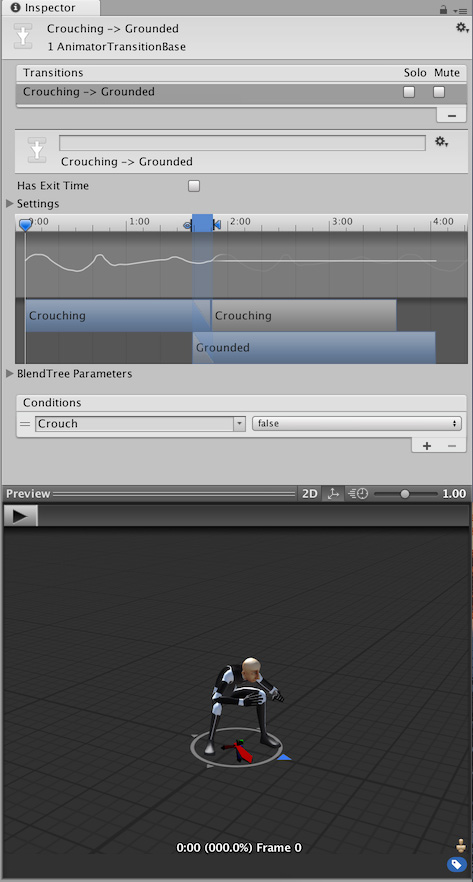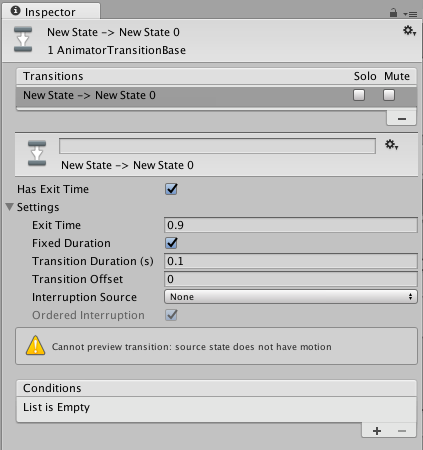How Do You Set Conditions To Switch Animations In The Animator?
Animation transitions
Animation transitions let the state machineThe gear up of states in an Animator Controller that a grapheme or animated GameObject can be in, along with a set of transitions between those states and a variable to remember the electric current state. The states available volition depend on the blazon of gameplay, but typical states include things like idling, walking, running and jumping. More info
Meet in Glossary to switch or alloy from one animation land to another. Transitions ascertain not simply how long the alloy between states should accept, but also under what conditions they should actuate. You can gear up a transition to occur only when certain conditions are true. To set upwardly these conditions, specify values of parameters in the Animator Controller Controls animation through Blitheness Layers with Animation State Machines and Animation Blend Copse, controlled past Animation Parameters. The same Animator Controller can be referenced past multiple models with Animator components. More than info
See in Glossary .
For example, your graphic symbol might take a "patrolling" land and a "sleeping" state. You could gear up the transition between patrolling and sleeping to occur just when an "alertness" parameter value drops beneath a sure level.

To give transitions a proper noun, type it into the field equally shown below:

The Inspector A Unity window that displays information about the currently selected GameObject, asset or project settings, allowing y'all to inspect and edit the values. More info
Come across in Glossary window of a state shows the transitions the state uses equally shown below:

In that location can be but one transition active at whatsoever given fourth dimension. All the same, the currently agile transition can be interrupted by another transition if you have configured the settings to allow it (see Transition Interruption beneath).
Transition properties
To view properties for a transition, click on the transition line connecting two states in the Animator window The window where the Animator Controller is visualized and edited. More info
Encounter in Glossary . The backdrop appear in the Inspector window.

Use the following properties to arrange the transition and how it blends between the electric current and next country.
| Property | Function |
|---|---|
| Has Exit Time | Leave Time is a special transition that doesn't rely on a parameter. Instead, information technology relies on the normalized time of the state. Check to make the transition happen at the specific time specified in Exit Time. |
| Settings | Fold-out bill of fare containing detailed transition settings as below. |
| Exit Time | If Has Exit Time is checked, this value represents the exact time at which the transition can accept event. This is represented in normalized time (for example, an exit time of 0.75 means that on the first frame where 75% of the animation has played, the Exit Time condition is truthful). On the adjacent frame, the status is false. For looped animations, transitions with exit times smaller than 1 are evaluated every loop, so you lot tin can use this to time your transition with the proper timing in the animation every loop. Transitions with an Exit Time greater than 1 are evaluated only once, so they can be used to exit at a specific fourth dimension after a fixed number of loops. For example, a transition with an exit time of 3.5 are evaluated once, afterwards three and a half loops. |
| Stock-still Elapsing | If the Stock-still Elapsing box is checked, the transition time is interpreted in seconds. If the Stock-still Elapsing box is non checked, the transition time is interpreted as a fraction of the normalized fourth dimension of the source state. |
| Transition Elapsing | The duration of the transition, in normalized time or seconds depending on the Fixed Duration mode, relative to the current state'due south duration. This is visualized in the transition graph equally the portion between the two bluish markers. |
| Transition Offset | The outset of the fourth dimension to begin playing in the destination country which is transitioned to. For instance, a value of 0.5 means the target state begins playing at 50% of the way through its own timeline. |
| Interruption Source | Utilize this to control the circumstances under which this transition may be interrupted (see Transition pause below). |
| Ordered Intermission | Determines whether the electric current transition can be interrupted by other transitions independently of their order (see Transition interruption below). |
| Conditions | A transition can take a single condition, multiple conditions, or no weather condition at all. If your transition has no atmospheric condition, the Unity Editor only considers the Get out Fourth dimension, and the transition occurs when the go out time is reached. If your transition has 1 or more than atmospheric condition, the weather must all be met before the transition is triggered. A condition consists of: - An event parameter (the value considered in the condition). If you lot have Has Exit Fourth dimension selected for the transition and have one or more conditions, note that the Unity Editor considers whether the weather are true after the Leave Fourth dimension. This allows y'all to ensure that your transition occurs during a sure portion of the animation. |
Transition interruption
Use the Suspension Source and Ordered Interruption properties to control how your transition tin can exist interrupted.
The pause order works, conceptually, as if transitions are queued and then parsed for a valid transition from the first transition inserted to the last.
Interruption Source belongings
The transitions in AnyState are always added commencement in the queue, then other transitions are queued depending on the value of Interruption Source:
| Value | Office |
|---|---|
| None | Don't add whatever more transitions. |
| Current State | Queue the transitions from the current state. |
| Next State | Queue the transitions from the next state. |
| Current State and then Next Country | Queue the transitions from the current land, and then queue the ones from the next state. |
| Adjacent State then Current State | Queue the transitions from the next state, then queue the ones from the current state. |
Ordered Intermission belongings
The holding Ordered Suspension changes how the queue is parsed.
Depending on its value, parsing the queue ends at a different moment as listed below.
| Value | Ends when |
|---|---|
| Checked | A valid transition or the current transition has been found. |
| Unchecked | A valid transition has been found. |
But an AnyState transition can be interrupted by itself.
To acquire more well-nigh transition interruptions, meet the Unity blog post Country Motorcar Transition Interruptions.
Transition graph
To manually adjust the settings listed above, you tin either enter numbers straight into the fields or apply the transition graph. The transition graph modifies the values above when the visual elements are manipulated.
Change the transition backdrop in the graph view using the following directions::
- Elevate the Duration "out" marker to modify the Duration of the transition.
- Elevate the Elapsing "in" marker to change the duration of the transition and the Exit Fourth dimension.
- Drag the target state to accommodate the Transition First.
- Drag the preview playback mark to scrub through the animation blend in the preview window at the bottom of the Inspector.
Transitions betwixt Blend Tree states
If either the current or next state belonging to this transition is a Blend Tree state, the Blend Tree parameters appear in the Inspector. Adjust these values to preview how your transition would look with the Blend Tree values set to unlike configurations. If your Blend Tree contains clips of differing lengths, you should test what your transition looks like when showing both the brusk prune and the long clip. Adjusting these values does not affect how the transition behaves at runtime; they are solely for helping yous preview how the transition could await in dissimilar situations.

Conditions
A transition can have a single condition, multiple weather, or no conditions at all. If your transition has no conditions, the Unity Editor just considers the Exit Fourth dimension, and the transition occurs when the go out time is reached. If your transition has one or more conditions, the conditions must all exist met earlier the transition is triggered.
A condition consists of:
- An upshot parameter, the value of which is considered in the status.
- A conditional predicate, if needed (for example, less or greater for floats).
- A parameter value, if needed.
If Has Exit Time is enabled for the transition and has one or more than conditions, these weather are only checked after the exit time of the country. This allows you to ensure that your transition only occurs during a certain portion of the blitheness.
Source: https://docs.unity3d.com/Manual/class-Transition.html
Posted by: huttonlecoany.blogspot.com

0 Response to "How Do You Set Conditions To Switch Animations In The Animator?"
Post a Comment